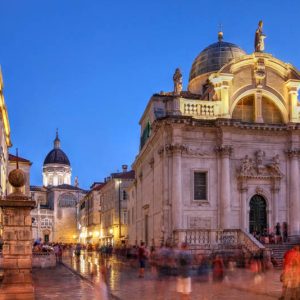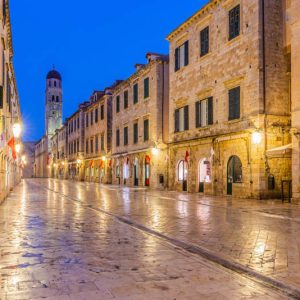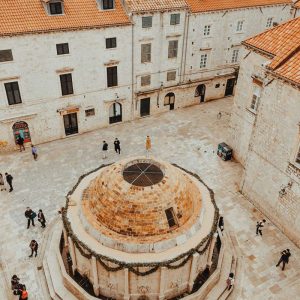
The picturesque Old Town of Dubrovnik, surrounded by impressive city walls, has been a UNESCO World Heritage Site since 1979. This historic gem boasts well-preserved medieval architecture and offers a wealth of cultural and historical sights waiting to be discovered.
Considered one of the best-preserved examples of medieval cities, Dubrovnik’s Old Town is now a living open-air museum.
Strolling through the narrow streets of the Old Town takes visitors to magnificent palaces, impressive churches and lively squares, all imbued with an aura of times gone by. Dubrovnik’s Old Town offers a unique combination of history, culture and breathtaking beauty.

The history of Dubrovnik goes back a long way and is rich in events and cultural development. Originally known as an Illyrian settlement under the name Ragusa, the city was founded in the 7th century by refugees from Epidaurum (now Cavtat). This settlement quickly developed into a major trading center on the Adriatic coast, attracting merchants from various parts of Europe.
During the Middle Ages, Dubrovnik Old Town flourished. The city joined the Byzantine Empire and gained wealth and power through its trade with Venice, the Ottoman Empire and other Mediterranean countries. This economic strength enabled the construction of magnificent buildings and the development of a strong defensive structure.
During the Croatian war in the 1990s, Dubrovnik suffered severe damage. However, thanks to extensive restoration work, the old town and its valuable monuments have been largely restored. Today, Dubrovnik’s old town shines in new splendor and attracts millions of tourists every year who want to experience its rich history and culture.
Dubrovnik Old Town, declared a UNESCO World Heritage Site in 1979, is an impressive example of medieval town planning and architecture. The thick city walls, the magnificent churches and palaces, and the charming streets and squares reflect the rich and varied history of this fascinating city.

The wall, which is up to 25 metres high and six metres wide in some places, was built to defend the city against attacks from sea and land. It is a prime example of medieval military architecture and one of the best-preserved fortification systems in Europe.
Walking on the Dubrovnik city walls is an unmissable experience for every visitor. The walking tour, which lasts about 1.5 to 2 hours, offers stunning panoramic views of the Old Town, the azure sea and the surrounding landscapes. It is advisable to start the walk in the early morning or late afternoon to avoid the crowds and the heat of the day.
Dubrovnik Cathedral, also known as the Cathedral of the Assumption of the Virgin Mary, is a magnificent example of Baroque architecture
The facade of the cathedral is impressive, with its large pilasters, niches with statues, and a large central window that fills the interior of the church with natural light. The interior of the cathedral is equally impressive, with an ornate main altar and several side chapels, each decorated with ornate paintings and sculptures.
A particularly fascinating aspect of Dubrovnik Cathedral can be seen at night. As the sun sets and the city is bathed in a soft light, the cathedral’s great dome shines in all its glory.
The nighttime illumination highlights the architectural details of the cathedral and creates an almost mystical atmosphere. This nighttime scenery makes the cathedral a popular subject for photographers and a romantic attraction for evening strolls through the old town.

The Stradun is about 300 meters long and was rebuilt in the Baroque style after a devastating earthquake in 1667 that destroyed large parts of Dubrovnik’s Old Town.
The Stradun is not only an architectural masterpiece, but also the beating heart of Dubrovnik’s Old Town. The street is lined with numerous shops, boutiques and souvenir shops offering a variety of products, from handmade goods to high-end fashion items. This makes the Stradun a popular shopping destination for tourists and locals alike.
The atmosphere on Stradun is a mix of historic charm and vibrant urban life. A stroll along this street allows you to admire the well-preserved Baroque architecture while experiencing the hustle and bustle that makes this central axis of the Old Town so special.

The Great Onofrio Fountain, located at the western end of the Stradun near the Pile Gate, is particularly impressive. With its circular basin and central dome, it is a popular meeting place and a prominent landmark of the city. The fountain is decorated with 16 carved masks from which the water gushes, and served as the city’s main water supply in the Middle Ages.
The Small Onofrio Fountain is located at the eastern end of the Stradun, near the Ploče Gate and Sponza Palace. Although smaller and less elaborate than its large counterpart, it serves a similar function and is a charming sight.
Both fountains were designed and built in the 15th century by the Neapolitan architect Onofrio della Cava to supply the city with fresh water from a spring about 20 kilometers away. They are integral parts of Dubrovnik’s historic water supply system and testaments to the engineering skills of the time.
The Pile Gate and the Ploče Gate are the two main entrances to Dubrovnik’s Old Town and serve as important connecting routes for visitors and locals. The Pile Gate, located west of the Old Town, is the main entrance and an impressive example of medieval architecture. It consists of an outer and an inner gate, connected by a drawbridge that once crossed a moat.
The Ploče Gate, east of the Old Town, provides another important entrance and is similar in structure to the Pile Gate. Here too there is a combination of outer and inner gates, connected by a bridge.
Historically, both gates played a central role in the defense and control of the city. Both gates are decorated with magnificent statues and ornaments that reflect Dubrovnik’s rich history and cultural heritage.
Sponza Palace is one of the most magnificent buildings in Dubrovnik’s Old Town and an outstanding example of Dalmatian Renaissance architecture. Built in the early 16th century, it combines Gothic and Renaissance elements.
The palace originally served as a customs house and was a central point for trade in Dubrovnik. Merchants from all over the world came here to clear their goods and conduct business. In addition, Sponza Palace has been used for various purposes over the centuries, including as a mint, treasury and bank.
Nowadays, Sponza Palace houses the Dubrovnik State Archives, which houses valuable documents and historical writings. This collection includes important records dating back to the 12th century and provides an invaluable insight into the city’s history and cultural heritage.
In addition to its function as an archive, the Sponza Palace also serves as an exhibition venue for various cultural events and exhibitions. Visitors can view changing exhibitions here that cover both historical and contemporary topics.
The Franciscan Monastery in Dubrovnik is an impressive example of medieval architecture and an important cultural heritage of the city. The monastery was originally built in the 14th century, but was rebuilt and expanded several times due to wars and natural disasters. After a devastating earthquake in 1667, it was rebuilt in the Baroque style, preserving many Gothic and Romanesque elements.
A prominent feature of the Franciscan monastery is the picturesque courtyard, which is surrounded by about 120 finely crafted columns. Each of these columns is individually decorated and features elaborate reliefs depicting various plant and animal motifs.
The monastery church houses one of the oldest pharmacies in Europe, which has been in operation since 1317 and now serves as a museum.
The Franciscan monastery houses a museum that exhibits a valuable collection of sacred artworks, manuscripts and historical artifacts. Particularly noteworthy are the old medical equipment and recipes from the pharmacy, which offer a fascinating insight into the medical history of the Middle Ages.
Dubrovnik Old Town is a true gem of the Adriatic, combining rich history and impressive architecture. For an unforgettable visit to Dubrovnik Old Town, we recommend starting the day early to avoid the crowds and enjoy the fresh morning air.
Start at the Pile Gate and take a walk on the city walls to enjoy the impressive views. Then, explore the main street, Stradun, and take a break in one of the many charming cafes.
Don’t miss the historic Onofrio’s Fountains and Sponza Palace, which offers a fascinating insight into Dubrovnik’s past. A visit to the Franciscan Monastery is also worthwhile, especially its tranquil courtyard and museum. Plan your evening so that you can see Dubrovnik Cathedral at night – the illuminated dome is a sight to behold.
The Old Town of Dubrovnik offers a perfect mix of history, culture and picturesque beauty that captivates every visitor.